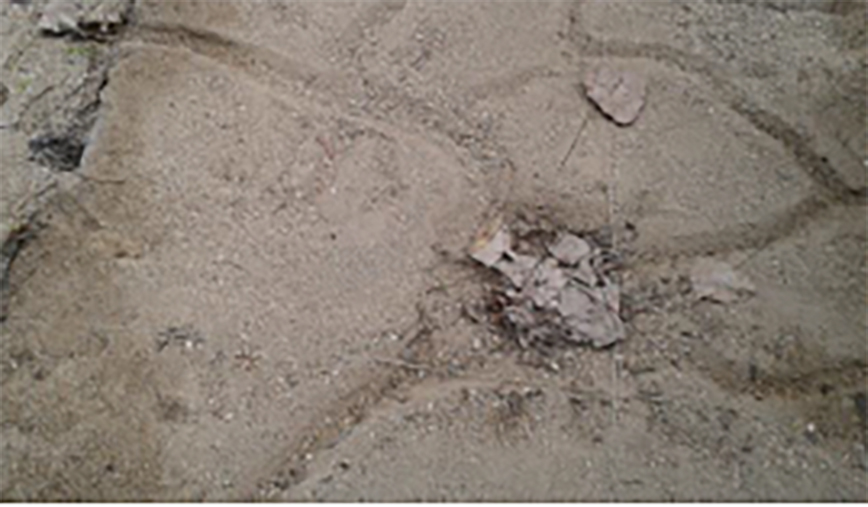October 3, 2014 Arch Pits
A leafy nest surrounded by a network of shallow tunnels are two hallmarks of a common but rarely seen local mammal, the northern short-tailed shrew.
Earlier this week, a couple members of the St. Charles Park District naturalist staff headed out to complete some prep work for an upcoming school program.
Now, this news in itself isn’t earth-shaking, nor even groundbreaking. Over the course of a year we prep our outdoor teaching areas for, give or take, eight different programs that reach more than 6,000 area students.
This week’s job though was, literally, the pits.
Nature Programs Coordinator Lisa O’Brien and I were deep within the Hickory Knolls Natural Area, removing the plywood covers from the archeological dig site—said pits–we’ve simulated near the park’s pothole wetlands.
The boards, in place for 11 months out of the year, allow mini-ecosystems to develop in the sandy soil that lies beneath. Spiders and centipedes feed on insects and other arthropods; millipedes munch on decaying plant material. Last year we even found a couple of well-concealed tiger salamanders, both of which promptly retreated deep into their burrows when we lifted the lid on their world.
Big fans of biodiversity—the variety of life that healthy environments display—Lisa and I each year anticipate the sorts of treasures we’ll find underneath the boards at the pits. As the broader-minded of the two of us, Lisa wondered aloud whether we’d find salamanders again, or maybe mammals of some sort. I, meanwhile, was hoping for snakes.
As it turned out, neither one of us was disappointed.
Fourteen 4-x-8-ft. sheets of plywood cover the pits, and from the start we knew we’d be in for a treat. Board Nos. 3 and 4 had warped a bit, and No. 5 displayed signs of being gnawed.
These small openings seemed like they’d appeal to a variety of small woodland creatures seeking cover for a day, a night or even a season. As we removed the screws that (mostly) held the panels in place, then lifted the boards, we saw all manner of creepy-crawlies—beetles, crickets, daddy longlegs—as well as much forest detritus—cottonwood down, dried leaves, assorted twigs and stems. And, running throughout, deep grooves in the sand—tunnels!
Continuing our work, we found the network of channels to be quite complex. We came across a “pantry”—a food cache containing acorns and other small seeds; a “bedroom” consisting of cottonwood leaves tightly woven into a ball; and an area way off to the side that would probably best be described as a latrine.
As we analyzed the scene before us, we were momentarily distracted by the appearance of another pit resident, a young eastern garter snake, Thamnophis sirtalis. I was thrilled! Lisa, well, not so much.
A silver dollar-sized hole at the north end of the first pit gave us a strong indication of whom our pit-dweller might be. Familiar with holes of this sort, we both surmised its excavator was an eastern chipmunk, Tamias striatus.
At first, Lisa and I marveled at magnitude of what we imagined to be the industrious rodent’s creation. That pit measures 8 ft. wide and about 28 ft. long, and tunnels traversed virtually every segment. The hole, we later discovered, was actually the entrance to an “underpass” that led to the other pit, which was replete with more tunnels, more caches and another sleeping chamber.
But something about this cozy arrangement didn’t seem quite right—most notably, the “latrine.” Chipmunk scat, by and large, is pelleted and closely resembles that of mice and rats. The deposits we were looking at though were longer and, for lack of better word, stringier.
Adding to the intrigue, an interesting odor pervaded the area closest to the burrow entrance. Somewhat musky, a wee bit rancid, it could best be described as a funk, dank and dark, hanging there in the humid air.
Once again Lisa and I stopped to try and interpret the signs that surrounded us. Could something other than a chipmunk be responsible?
The answer came to us rather suddenly—and left us just as fast. A streak of gray scuttled out of the burrow, took cover briefly beneath my crouched legs, then propelled itself towards the nearby brush and was gone.
A shrew! Specifically, Blarina brevicauda, the northern short-tailed shrew.
Suddenly, the diverse signs all added up. Shrews make use of elaborate tunnel systems; they cache food–including nuts, even though they are primarily carnivorous; they build ball-shaped nests; and they devote at least one underground chamber to restroom activities.
The musky odor made sense too, as short-tailed shrews use special glands to mark their territories with scent. The rankness could have been due to the shrew itself, or perhaps an unconsumed bit of meaty prey left somewhere close by.
What we didn’t get to investigate, and wish we had, were a couple of features that have made these mammals famous: Their blood-red teeth (due to iron in their tooth enamel), and their venom.
Yep, that’s right, short-tailed shrews are one of only a handful of mammals worldwide that are venomous. Used to subdue prey, the toxin allows shrews to take down animals much larger than themselves. Thanks to this considerable advantage, shrews’ diets can include mice, frogs, snakes, birds and—get this—salamanders. The animals we’d thought we’d find.
Shrew present, salamanders absent. A coincidence? I think not.
As we made our way back to the office to attend to other tasks, Lisa and I couldn’t help but feel a might envious. Tunnels, chambers and caches; red teeth and venom. Compared to our mundane work as mere humans, there’s no business like shrew business.
Pam Erickson Otto is the manager of nature programs and interpretive services at the Hickory Knolls Discovery Center, a facility of the St. Charles Park District. She can be reached at 630-513-4346 or potto@stcparks.org.

